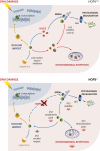HOPS and p53: thick as thieves in life and death
- PMID: 33112208
- PMCID: PMC7714459
- DOI: 10.1080/15384101.2020.1838772
HOPS and p53: thick as thieves in life and death
Abstract
The oncosuppressor protein p53 plays a major role in transcriptionally controlling the expression of a number of genes, which in turn regulates many functions in response to DNA damage, oncogene triggering, oxidative, and additional cell stresses. A developing area of interest in p53 is the studies related to its cytoplasmic function(s). Many investigations revealed the significant role of p53 in the cytoplasm, acting in a transcriptional-independent manner in important processes related to cell homeostasis such as; apoptosis, autophagy, metabolism control, drug, and oxidative stress response. The studies on cytoplasmic p53 have shown intricate mechanisms by which posttranslational modifications allow p53 to perform its cytoplasmic functions. A number of ubiquitins, deubiquitins, and small ubiquitin-like proteins, have a pivotal role in controlling cytoplasmic stability and localization. Recently, HOPS/TMUB1 a novel small ubiquitin-like protein has been described as a vital molecule stabilizing p53 half-life, directing it to the mitochondria and favoring p53-mediated apoptosis. Furthermore, HOPS/TMUB1 competing with importin-α lessens p53 nuclear localization, thereby increasing cytoplasmic concentration. HOPS/TMUB1 as p53 modifiers could be attractive candidates to elucidate apoptosis or other important transcriptional-independent functions which are key in cancer research in order to develop new therapeutic approaches.
Keywords: Apoptosis; Hepatocyte Odd Protein Shuttling (HOPS); Liver regeneration; Mitochondrial Apoptosis; Nucleophosmin (NPM)/p19 Arf; Transmembrane and ubiquitin-like domain containing 1 (TMUB1); Tumor Suppressor Gene; Ubiquitin–Like Protein; p53.
Conflict of interest statement
No potential conflict of interest was reported by the author.
Figures



Similar articles
-
The Ins and Outs of HOPS/TMUB1 in biology and pathology.FEBS J. 2021 May;288(9):2773-2783. doi: 10.1111/febs.15539. Epub 2020 Sep 13. FEBS J. 2021. PMID: 32860479 Review.
-
HOPS/TMUB1 retains p53 in the cytoplasm and sustains p53-dependent mitochondrial apoptosis.EMBO Rep. 2020 Feb 5;21(2):e48073. doi: 10.15252/embr.201948073. Epub 2019 Dec 23. EMBO Rep. 2020. PMID: 31867855 Free PMC article.
-
HOPS/Tmub1 involvement in the NF-kB-mediated inflammatory response through the modulation of TRAF6.Cell Death Dis. 2020 Oct 15;11(10):865. doi: 10.1038/s41419-020-03086-5. Cell Death Dis. 2020. PMID: 33060567 Free PMC article.
-
Different functions of HOPS isoforms in the cell: HOPS shuttling isoform is determined by RIP cleavage system.Cell Cycle. 2014;13(2):293-302. doi: 10.4161/cc.27054. Epub 2013 Feb 1. Cell Cycle. 2014. PMID: 24240191 Free PMC article.
-
Cytoplasmic functions of the tumour suppressor p53.Nature. 2009 Apr 30;458(7242):1127-30. doi: 10.1038/nature07986. Nature. 2009. PMID: 19407794 Free PMC article. Review.
Cited by
-
The Four Homeostasis Knights: In Balance upon Post-Translational Modifications.Int J Mol Sci. 2022 Nov 21;23(22):14480. doi: 10.3390/ijms232214480. Int J Mol Sci. 2022. PMID: 36430960 Free PMC article. Review.
-
Hops/Tmub1 Heterozygous Mouse Shows Haploinsufficiency Effect in Influencing p53-Mediated Apoptosis.Int J Mol Sci. 2021 Jul 2;22(13):7186. doi: 10.3390/ijms22137186. Int J Mol Sci. 2021. PMID: 34281239 Free PMC article.
-
The role of interaction between autophagy and apoptosis in tumorigenesis (Review).Oncol Rep. 2022 Dec;48(6):208. doi: 10.3892/or.2022.8423. Epub 2022 Oct 12. Oncol Rep. 2022. PMID: 36222296 Free PMC article. Review.
-
Development and Validation of a Five-RNA-Based Signature and Identification of Candidate Drugs for Neuroblastoma.Front Genet. 2021 Oct 20;12:685646. doi: 10.3389/fgene.2021.685646. eCollection 2021. Front Genet. 2021. PMID: 34745201 Free PMC article.
-
HOPS/TMUB1 Enhances Apoptosis in TP53 Mutation-Independent Setting in Human Cancers.Int J Mol Sci. 2024 Apr 23;25(9):4600. doi: 10.3390/ijms25094600. Int J Mol Sci. 2024. PMID: 38731819 Free PMC article.
References
-
- Oren M. Decision making by p53: life, death and cancer. Cell Death Differ. 2003;10:431–442. - PubMed
-
- Muller PA, Vousden KH.. p53 mutations in cancer. Nat Cell Biol. 2013;15:2–8. - PubMed
-
- Vousden KH, Prives C. Blinded by the light: the growing complexity of p53. Cell. 2009;137:413–431. - PubMed
-
- Comel A, Sorrentino G, Capaci V, et al. The cytoplasmic side of p53’s oncosuppressive activities. FEBS Lett. 2014;588:2600–2609. - PubMed
Publication types
MeSH terms
Substances
LinkOut - more resources
Full Text Sources
Research Materials
Miscellaneous
